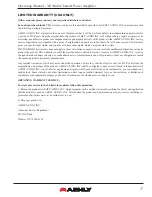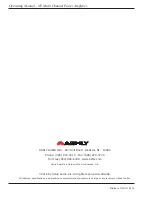
Operating Manual - NE Multi Channel Power Amplifier
12
5. PROTEA
ne
SOFTWARE
Protea
ne
software offers a comprehensive suite of tools for controlling Ashly NE multichannel amplifiers. The standard amplifiers
allow for Ethernet control and monitoring of power functions, mute, and preset control. With the DSP option installed, software
control and monitoring of audio functions can be custom configured on a per channel basis, as well as through linked channels.
More in depth discussion of software features can be found in the Protea
ne
software online help.
The base amplifier interface includes a main control surface, password protected security functions, and network property
management. Link Group Configuration and Power On Delay* can be set up under the Device Options menu tab. In addition,
provisions for implementing DSP functions, AES/EBU Inputs, and network audio inputs are available, presuming the neces
-
sary hardware options have been installed in the amplifier. Protea
ne
software will auto-detect any installed hardware options and
display the resulting menu items once it recognizes the amplifier on the network.
*
Note
-
Power On Delay does not work when standby mode is activated via contact closure.
Link Group Configuration
- Linking allows the controls for multiple DSP function blocks to track each other. For example, if
two different graphic equalizer blocks are assigned to a link group, any change made to a control within either of the equalizers
will result in an identical change to the other. Blocks may be linked across channels.
Each device will support up to 16 link groups. DSP function blocks can be individually assigned to these link groups. Once
assigned to a group, all similar functions within that group will track parameter changes. More than one function type may be
assigned to a group. Each link group can be assigned a name by the user, and can also be assigned a color for easy identification.
For further details about linking, see the software online help.
Preset Options
- The preset options menu allows amplifier setups to be saved to or recalled from an amplifier or a computer.
File
presets
are the complete amplifier and software settings, whereas
device presets
are limited to commonly used functions.
Sub Presets
- Sub Presets are user defined groups of DSP functions within one channel or across multiple channels. Sub Presets
allow the user to instantly recall a pre-determined set of DSP parameters to quickly address changing environmental conditions,
without the risk of making undesirable or irrecoverable system changes.
The Amplifier Control Surface Tab
The control surface tab is the main software interface for the amplifier. Key features of this window include:
1) Channel and Offset Link Group Faders - The main level control provides up to 40dB of analog input attenuation. More than
40dB of cumulative attenuation causes the channel to mute. If a channel has been assigned to an offset link group, a colored
triangular marker appears on the left side of the fader graticule for secondary level control of all channels in that group. The
main level control faders can not be linked to a group.
2) Mute button - This mutes the input channel
3) Polarity button - This inverts the phase of the input channel
4) Offset link group - Up to 16 groups are available for the purpose of linking similar function parameters across multiple chan
-
nels. In addition to the control surface secondary level control (not the main fader), most DSP functions have a link group check
box in their work window to assign a specific parameter to one of the eight link groups if desired. Link groups can be renamed
by clicking on any group name and entering the new name then pressing <enter> on the keyboard.
5) Attenuators - These two dials indicate the physical position of hardware controls on either the amp front panel or remote
DC level control (if present). Note that these will display the position of attenuators even when they are disabled by software.
6) Total Attenuation - This indicates the total amount of attenuation being applied to the channel. This is the sum of the follow
-
ing attenuators: main fader, offset link group attenuation, front panel and remote attenuators.
7) Meters - Input and Output meters display the real time activity per channel, in dB below rated output. Also, the amplifier’s
operating temperature and output current are shown. Output current shows that the amplifier channel is actually delivering
output to a connected speaker load.




















